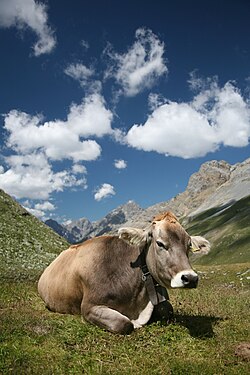Asparagopsis taxiformis
| Limu Kohu | |
|---|---|

| |
| Asparagopsis taxiformis in Mayotte. | |
| Scientific classification | |
| Clade: | Archaeplastida |
| Division: | Rhodophyta |
| Class: | Florideophyceae |
| Order: | Bonnemaisoniales |
| Family: | Bonnemaisoniaceae |
| Genus: | Asparagopsis |
| Species: | A. taxiformis
|
| Binomial name | |
| Asparagopsis taxiformis | |
| Synonyms | |
|
Asparagopsis sanfordiana | |
Asparagopsis taxiformis (red sea plume or limu kohu), formerly A. sanfordiana,
Lifecycle
Like many
Culinary uses
Asparagopsis is one of the most popular types of
The essential oil of limu kohu is 80% bromoform (tri-bromo-methane) by weight.[8] It also includes many other bromine- and iodine-containing organic compounds.[5]
Methane emissions reduction in ruminants


In 2014, researchers at CSIRO and James Cook University (supported by Meat & Livestock Australia) demonstrated that treating ruminal fluid with one to two percent red seaweed reduced their methane emissions by over 90 percent.[9] Of 30 types of seaweed tested, A. taxiformis showed the most promise, with nearly 99 percent effectiveness.[10]
The findings spurred further investigation into its effects on ruminant animal enteric methane production. In 2016, the same team showed that 2-5% of seaweed biomass effectively reduced production by 98-100%[11] in vitro and, in a separate study, identified the bioactives in A. taxiformis. While dichloromethane extract was the most potent bioactive, reducing methane production by 79%, bromoform and dibromochloromethane had the highest activity inhibiting methane production, and only bromoform is present in sufficient quantities to be effective.[12] In 2020, they showed that a 0.2% addition of A. taxiformis to cattle’s feed reduced the livestock’s methane emissions by over 98%.[13] In 2021, a team from UC Davis found that additions of 0.25% and 0.5% reduced cattle’s enteric methane emissions by 69.8% and 80% respectively.[14]
Supply from wild harvest is not expected to be adequate to support broad adoption. Subsequent to the Australian study, CSIRO established FutureFeed Pty Ltd., which holds the global intellectual property (IP) rights for the use of Asparagopsis for livestock feed, with the aim of significantly reducing enteric methane emissions in ruminants.[15] In 2020, FutureFeed won a Food Planet Prize worth USD $1 million for the research behind its inception.[16]
Aquaculture
A. taxiformis has yet to be commercially farmed at scale, but several companies are working towards it as they make the seaweed available to the livestock industry. A research/development initiative called Greener Grazing is seeking to close the life cycle of A. taxiformis and demonstrate ocean-based grow-out.[17]
A startup out of KTH Royal Institute of Technology, Volta Greentech, Sea Forest, SeaStock, Immersion Group, Synergraze, Symbrosia and Blue Ocean Barns, are growing A. taxiformis in vertical, near-shore land-based tanks, using seawater to provide the proper temperature and nutrients.[18][19] Symbrosia, from Yale University, is looking to integrate the cultivation with whiteleg shrimp on land, using a patent-pending technology.[20] Another start-up, CH4 Global, has developed energy-efficient EcoParks in Australia and New Zealand to produce A. taxiformis for use in its solutions for feedlot cattle.[21] CH4 Global has partnered with Clean Seas to grow A. taxiformis at Arno Bay, Australia, where it uses carbon and nitrogen waste from Clean Seas’ ocean-based fish farms as food for the seaweed.[22] In 2023 CH4 global reported its first commercial sale and intentions to feed the additive to 10,000 cattle.[23]
Volta Greentech, Blue Ocean Barns, Symbrosia and CH4 Global have been backed by venture capital funds.
See also
- Algaculture – Aquaculture involving the farming of algae
- Edible seaweed – Algae that can be eaten and used for culinary purposes
- Limu (algae) – Edible plants living under water or near water
References
- S2CID 53065361.
- ^ "Asparagopsis taxiformis". Algaebase. Retrieved 2016-10-19.
- S2CID 216251207.
- University of Hawaii Press. Retrieved October 8, 2010.
- ^ .
- University of Hawaii Press. Retrieved October 8, 2010.
- ^ Fortner, Heather J. (1978). "The Limu Eater: a cookbook of Hawaiian seaweed" (PDF). Archived (PDF) from the original on 2022-01-04. Retrieved 4 February 2021.
- .
- PMID 24465524.
- ^ "Seaweed could hold the key to cutting methane emissions from cow burps - CSIROscope". CSIROscope. 2016-10-14. Retrieved 2018-10-01.
- S2CID 86220977.
- ^ "Identification of bioactives from the red seaweed Asparagopsis taxiformis that promote antimethanogenic activity in vitro". ResearchGate.
- S2CID 216251207.
- PMID 33730064.
- ^ WO2015109362A2, MACHADO, Lorenna; MAGNUSSON, Marie Elisabeth & TOMKINS, Nigel William et al., "Method for reducing total gas production and/or methane production in a ruminant animal", issued 2015-07-30
- ^ "FutureFeed". Food Planet Prize. Retrieved 2022-12-02.
- ^ "Gassy cows are bad for the planet; could seaweed diet help?". AP News. Retrieved 2018-10-01.
- ^ Tatiana Schlossberg (November 27, 2020). "An unusual snack for cows, a powerful fix for climate; Feeding them seaweed slashes the amount of methane they burp into the atmosphere," The Washington Post.
- ^ Duggan, Tara (October 27, 2021). "Dairy cows' greenhouse gas emissions cut by 52% after eating seaweed at Bay Area farm". San Francisco Chronicle.
- ^ "Symbrosia". Tsai CITY. Retrieved 2022-12-02.
- ^ Moore, Gareth (2022-08-29). "The seaweed that could save the earth". www.fishfarmingexpert.com (in Norwegian Bokmål). Retrieved 2022-12-02.
- ^ "Kingfish and Asparagopsis producers team up". thefishsite.com. 3 August 2022. Retrieved 2022-12-02.
- ^ "Methane reducing- supplement- makes first commercial sale". www.tradefarmmachinery.com.au. 28 February 2024. Retrieved 2024-03-23.
External links
- Edible Limu of Hawaii
- Greener Grazing
- iNaturalist, especially for more photos.
- Guiry, M.D.; Guiry, G.M. "Asparagopsis taxiformis". AlgaeBase. University of Galway.
